Innovation, high principles, and a personal touch were hallmarks of Engineering’s third dean throughout his two careers and long life.
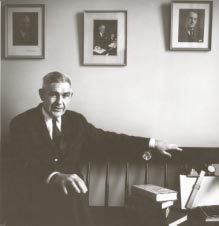
Rob Roy would have called it a brag. However, even today, the mere mention of his name triggers an unvarying response. For those former students, faculty, and alumni involved with the Johns Hopkins School of Engineering (or the entire University, for that matter) from the 1940s to the early ’70s, Robert H. “Rob” Roy ’28 remains one of the most remarkable men they have ever known. In fact, most don’t even bother making a distinction between the high professional regard and the deep personal affection they maintain to this day for the late Rob Roy.
Roy served as dean of the Engineering school from 1953 to 1966, and after that as dean for engineering sciences until retiring in 1973. As his former graduate student, colleague, and close friend Charles Flagle ’40, ’54 MA, ’55 PhD stated at an on-campus memorial service for Roy in October 2000, “These qualities—imagination, humanity, decency—Rob himself possessed in full measure….”
EARLY YEARS: THE EMERGING “POO-BAH”
Born in 1907 in the Walbrook neighborhood of West Baltimore, Roy first revealed his appetite for diverse interests as a student in the accelerated A Course at “Poly” (Baltimore Polytechnic Institute). While there, he favored mathematics, physics, and engineering; served on the student council and yearbook staff; and went out for football and lacrosse. In his 1990 self-published memoir, Bragolections: The Career Adventures of a Poo-Bah, Roy explained the origin of the title. “I was first called a Poo-Bah by Howard Batty, my English teacher at Baltimore Polytechnic Institute,” he recounts. “By this he meant that I was a jack-of-all-trades and master of none…If the shoe fits, I must wear it!” Roy, however, engineered the first word of the title, by splicing together “brag” and “recollections.”
After graduating from Poly in 1925, Roy enrolled directly into his sophomore year at Johns Hopkins in Mechanical Engineering, despite his admission that, “I really did not know what I wanted to do.”
While his opinion of his undergraduate coursework was mixed (he referred to one lab on internal combustion engines as “ridiculous”), Roy developed a steadily growing respect for Hopkins as an institution. “Unlike the reputation some universities had in the roaring twenties, Johns Hopkins was not a country club,” he wrote in Bragolections. “Sizeable fractions of the campus population were self-motivated scholars….Whether these collectively and unobtrusively set the pace I do not know, but, whatever the cause, there was engendered a love of learning that endured.”
Roy’s first taste of acclaim occurred as a senior when, along with the rest of the Hopkins varsity team, he represented the United States in lacrosse at the 1928 Summer Olympic Games in Amsterdam. In command of the American Olympic Committee was Army Maj. Gen. Douglas MacArthur. The Hopkins team played Canada and England to a triple-tie for the gold. “Nobody ever had as much fun as we did!” Roy recalled.
While an undergraduate, Roy encountered a mentor who would be instrumental in guiding him through his two careers and his lifelong professional focus: Professor A.G. Christie. A world authority in heat-power engineering, Christie was chair of the Mechanical Engineering Department. When Roy took Christie’s course on industrial organization and contracts, a switch was flicked. Roy had discovered his path and passion.
Still in its infancy, the field of industrial organization would eventually develop into the present-day study of industrial engineering. This study applies principles from both mathematics and engineering in decision-making to predict more accurately various complex system outcomes in order to optimize a given system’s performance. Such systems can be found in industry, government, and the military, and involve materials, equipment, energy, and people. In later years, many in this discipline would point to Roy as one of the leading contributors to its evolution and professionalization.
“THE SMELL OF PRINTER’S INK”
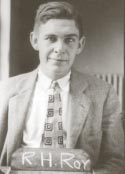
During his senior year at Hopkins, following a lead from Christie, Roy applied for a position at Waverly Press. The Baltimore firm, which included a sister company, Waverly & Wilkins Publishers, specialized in printing and publishing scholarly journals. Roy was attracted to the printing business. He was hired, and started work right after returning from the Olympics in the summer of 1928. On his first day, he began by learning how to set type by hand in Waverly’s composing room. He recalled his employer telling him that “…if I ever got the smell of printer’s ink in my nostrils I’d never get it out. He was right.” Roy stayed at Waverly for the next 19 years.
During his yearlong apprenticeship, Roy learned literally every mechanical and manual operation associated with printing. Then he began training as a salesman for the firm. However, he was finding that his real interests lay elsewhere. Prior to Roy’s arrival, Waverly had adopted a number of systems procedures through consultations with Frederick W. Taylor, the father of modern management science, and Taylor’s two associates, Morris Cooke and Henry Laurence Gantt. (Gantt earned his engineering mechanics degree at Hopkins in 1880. In 1917, two years before his death, he developed his innovative Gantt chart to project the progress of projects over a period of time.)
Roy was quickly drawn to the idea of time and motion studies, and began devouring books on the subject in the company’s library. He read Taylor’s Principles of Scientific Management and Gantt’s Work, Wages and Profits. Roy also was influenced by the motion-study engineers Frank and Lillian Gilbreth, whose pioneering studies in efficiency (and their amusing applications on the home front) were depicted in the 1950 film Cheaper By the Dozen. This new discipline, coupled with his abilities as a mechanical engineer, led Roy to invent both time-saving printing equipment and procedures for Waverly. The Roy type case accelerated the speed and accuracy of manual typesetting, and his system of compositing press forms greatly increased production. In 1936, he was appointed chief engineer of the firm; by 1947, Roy had become Waverly’s vice president of engineering and was regularly putting in 50 or more hours a week.
HOPKINS YEARS: “MUCH TO BE DONE”
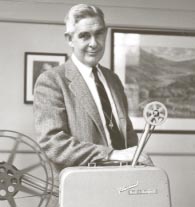
Although the alumnus had been separated from the University and the School of Engineering for nearly two decades, in one sense Rob Roy had never left. He regularly kept in touch with former classmates and professors. Then in 1939, Christie, his mentor, asked him to teach a class in industrial organization and management in the evening college.
By 1942, as a part of the University’s Engineering, Science & Management War Training Program, Roy was teaching industrial employees in two classes of 100-plus each, twice a week. While he had permission from his employers at Waverly, the teaching load put an enormous strain on Roy and his family. And starting in 1945, Roy was also actively pursuing a concurrent career as an industrial arbitration consultant. “He arbitrated huge cases for Lever Brothers, the Louisville Courier-Journal, and for Howard Head—the father of the modern ski,” recalls his elder daughter, Mollie R. Bucy, of Baltimore.
Obviously, something had to give. In the spring of 1947, Christie offered Roy an appointment as associate professor of industrial engineering in the Mechanical Engineering Department. Although the salary was roughly one-third of his pay at Waverly Press, Roy accepted. “I remarked more than once that if I didn’t get consulting we would starve,” Roy wrote in his memoir.
“HE LOVED THE UNIVERSITY ALMOST SECOND TO HIS FAMILY. IT WAS A WAY OF LIFE FOR HIM.” MOLLIE R. BUCY, ROY’S ELDER DAUGHTER
Starve he did not. In fact, within 18 months, Roy joined the Hopkins Engineering faculty as a full-time professor and chair of the school’s new Department of Industrial Engineering. “By the time A.G. Christie invited Rob to teach, Christie himself was about to retire,” recalls Flagle. “He knew Rob would be qualified to do that, and then to run the new department, because of his broad knowledge of management and organization theory, as well as his experience as a manager himself.”
Roy soon discovered that, in his own words, “there was much to be done” at Hopkins. A steady stream of veterans returning to college on the G.I. Bill had signed up for Industrial Engineering classes—few of which actually had instructors yet. Through his hard work and by leading several classes himself, he soon found his fledgling department was prospering. In short order, Roy’s own star rose as well. He was named an assistant dean in 1949 and four years later, in April 1953, he was named dean of Engineering, succeeding William B. “Wild Bill” Kouwenhoven (profiled in the Fall 2002 Johns Hopkins Engineer).
An entire book easily could be written on the accomplishments realized during Rob Roy’s 13-year tenure as dean. Suffice it to say, the School of Engineering was changed in substance, style, and approach. As Flagle recalls of his graduate school days with Roy in the early 1950s, “Engineering faced two challenges at the time. The first was that of becoming a broader form of education—it was possible at that point to graduate in the four-year undergraduate program with only one elective. At the same time, the technical context being learned was verging on the obsolete—the inventions that won World War II and fought the battle of Sputnik were not in engineering but in physics.”

As dean, Roy sought to modernize and broaden the scope of the engineering curriculum to include courses in the humanities and social sciences, as well as increased emphasis on professionalizing graduate students through real-world research projects and teaching experience. Joint appointments brought in senior faculty from Statistics, Psychology, and Political Economy. Roy’s goal—to build a program that produced not only excellent engineers but also world-class researchers and professors—was finally realized toward the end of his career. In the mid-1960s, the School of Engineering was awarded supporting grants from the Ford Foundation and the Alfred P. Sloan Foundation for a total of $2.185 million.
Within Roy’s Department of Industrial Engineering, which he continued to chair, important changes were also taking place. Following World War II, the Operations Research Office (ORO), which had been administered by Hopkins for the Army, needed a civilian home for its staff of researchers. The University agreed to take the ORO under its wing as a new department. Roy, who had a great interest in operations research and its systems analysis methodologies, lobbied to make the ORO part of his Department of Industrial Engineering. The integration took place, and a new department emerged—the Department of Operations Research and Industrial Engineering—with an instant faculty in the field of management science. Flagle laughs as he recalls the merger: “Much to their chagrin, all the philosophers, economists, sociologists, historians, and writers of the ORO overnight became industrial engineers. Anything for a parking space!”
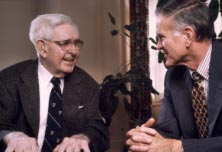
THE LATER YEARS: “DARE TO BE DIFFERENT”
The arrival of the 1960s found Rob Roy at the height of his professional achievement. He had already authored Management of Printing Production (1953) and The Administrative Process (1958). In 1961, along with his two co-editors—Flagle and William H. Huggins—Roy came out with “the book.” Operations Research and Systems Engineering is still considered the seminal text on the subject. Over his career, Roy would write more than 40 published works. Some have been translated into Dutch, Italian, Japanese, and Arabic, including the later acclaimed The Cultures of Management (1977) and Operations Technology: Systems and Evolution (1986). (Huggins, his co-editor, died in 2001; the professor emeritus had taught electrical engineering from 1954 through 1984 at Hopkins. To recognize outstanding students and teachers, and to support research, he had established the William H. Huggins Endowment for Electrical and Computer Engineering in the Whiting School.)
Other honors were forthcoming for Roy. In 1966, he was elected president of the American Society for Engineering Education. Then in 1967, he was accorded the highest honor given by the American Institute of Industrial Engineers—the Frank and Lillian Gilbreth Industrial Engineering Award. “That was a biggie,” recalls Bucy about this honor for her father. “That’s as high as an industrial engineer can go.”
Even with all of these accolades, Roy still experienced some disappointment during his final years at Hopkins. In 1966, he supported an initiative to merge the Homewood campus Philosophy and Engineering faculties into the School of Arts and Sciences, ostensibly to reduce curricular redundancies and promote interdisciplinary research. What resulted instead was a lack of identity and sense of loss for Hopkins Engineering, along with reduced representation at the new Academic Council. Key scholars departed; whole departments disappeared. Roy continued on as dean of engineering sciences, but was, in his words, “a dean without portfolio. My title… was only a title.”
Roy later wrote that “I have been well aware that there are many who blame me for what they regard as the destruction and necessary rebirth of the School of Engineering. I must accept these judgments; the merger turned out to be a bad idea.” Others would argue that the merger proved to be yet another key stage in the evolution of engineering at Johns Hopkins. Flagle observes that if you look closely at the Whiting School of Engineering (which opened its doors in 1979), you “see Rob Roy’s fingerprints all over it.”
In 1973, Roy was awarded emeritus status and quietly retired. However, retirement proved to be anything but quiet. With typical ebullience, the 66-year-old Roy threw himself into several new projects simultaneously. In addition to his ongoing writing, he entered public service as chair of the Maryland Hazardous Waste Facilities Sitting Board, chair of the Maryland Panel on Nuclear Policy (where he was instrumental in the development of the Calvert Cliffs Nuclear Power Plant), and chair of the Governor’s Advisory Committee on Science and Technology. Roy also chaired the Chesapeake Research Consortium, an environmental group, and was a long-time trustee (and chair) of the Board of Visitors and Governors of Washington College in Chestertown.
Roy’s former vocation in printing resurfaced as an avocation. In the basement of his home, he enjoyed setting metal type by hand, and did so for one of his books. He also made a point of attending nearly every lacrosse game at Homewood Field until he was well into his 80s. Roy often was invited out onto the field to accept the cheers of the crowd.
After his death in October 2000 at the age of 93, more than 200 former students, colleagues, family, and friends packed into the Garrett Room of the Milton S. Eisenhower Library for his memorial service. Hopkins, noted Bucy about her father, “was part of his soul, almost. He loved the University almost second to his family. It was a way of life for him.”
“TOMORROW’S ENGINEERING CHALLENGES WILL YIELD ONLY TO IMAGINATION ON THE PART OF YOUNG ENGINEERS WITH SOUND TRAINING WHO WILL DARE TO BE DIFFERENT.” ROBERT H. “ROB” ROY ’28
In 1951, Roy had argued that true innovation in engineering had never come from kowtowing to convention. In his February 1951 article in The Vector, a School of Engineering student magazine popular during the 1950s, he observed that tomorrow’s engineering challenges “will yield only to imagination on the part of young engineers with sound training who will dare to be different.” The jack-of-all-trades and master of several could have been writing about himself. And perhaps he was.
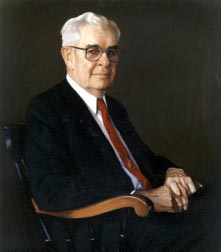
Rob Roy Remembered
“HE TREATED STUDENTS AS HIS EQUALS”
Ron Gue ’60, ’64 PhD is the founder, president, and CEO of Phoenix Health Systems (www.phoenixhealth.com). He formerly chaired the Computer Sciences Department at Southern Methodist University. A frequent industry speaker, Gue is the author of a textbook on applied mathematics, as well as numerous articles for professional journals.
“Rob Roy was a person of dignity, a professional with an open management style. He engendered respect. He treated students as his equals, but we all knew who was dean.
“As a PhD student in his department, I taught some courses for undergraduates and was invited to attend faculty meetings for the department. Meetings were always held in a private dining room in the Johns Hopkins Club. At various times, the number of faculty equaled the number of seats around the table. One day, many of us arrived earlier than Rob. When Rob arrived with one of the graduate instructors, there were only two seats left at either end of the table. The student stood there for a moment. Rob asked him what was wrong, and the student replied that he didn’t know which end is the head of the table. Rob replied, ‘When you sit down, you will define the head of the table.’”
“HE WAS THE GOOD SHEPHERD”
Charles Flagle ’40, ’54 MS, ’55 PhD, Rob Roy’s former student and colleague at Hopkins, was his close friend for nearly 50 years. A former professor in the Department of Mathematical Sciences at the Whiting School of Engineering, Flagle served under the U.S. Surgeon General in 1967-68 as special assistant for applied health technology. In 1978, he was elected to the Institute of Medicine of the National Academy of Sciences. Flagle also is professor emeritus of Health Policy and Management at the Johns Hopkins Bloomberg School of Public Health, where he taught for 30 years.
“There was a characteristic of Rob Roy that was an unusual one—he was the Good Shepherd, the guy who took the responsibility, took charge, and followed through. He was constantly shepherding his students and being there in a supportive role, especially with the wayward ones. If he saw someone in trouble, he would be proactive and try to help. I was often amazed what he would do and how he became involved in other people’s lives.
“Every year, he wrote an annual letter at Christmas that went to all of the graduates through the years—‘Rob’s boys’ as they were called. The letter included news and updates about Engineering alumni. Keeping in touch with all of the graduates of the department got to be a large number of people. But he didn’t stop, even after he retired.”
“HE JUST HID HIS LIGHT UNDER A SHADE”
Mollie R. Bucy, the elder daughter of Rob and Fifi Roy, resides with her family in the Ruxton home her parents built in 1939. Fifi died six weeks after her husband; they had been married for almost 70 years.
“Dad was a spectacular father in every way. His family was priority one for him. Half of what he accomplished, my sister Florrie and I never had much knowledge of, because he just hid his light under a shade. We had no idea that he had such a following or was as well-known as he was—until later on when we occasionally traveled with him and it was impossible to go to any airport in the country and not have somebody recognize him! It was unbelievable!
“Dad was a huge jokester—he had a fabulous sense of humor. He did terrible things to my aunts, my mother’s two sisters. One aunt was very house-proud and conservative. So Dad went out and bought a big cement chicken decoration and put it on my aunt’s front lawn one night.”
“ALL OF US WERE HIS SONS”
Don Fink ’59, ’61 MS, after graduating from Johns Hopkins as an industrial engineering major, joined what he kids was “an upstart company called IBM,” and later was a principal and executive vice president at DP/Associates. Fink currently is a financial coach and has been a generous volunteer and supporter in helping to build a base of funding for the Robert H. Roy Fellowship in the Whiting School.
“Rob was a class-A guy in all respects: articulate, accessible, an advocate, and a great administrator and advisor (stemming from the fact that he was a professional arbitrator). He had two daughters and no sons. We felt that all of us were his sons; he treated us as such. If you went to Rob with a problem that he felt could be addressed by contact with someone, he had a fantastic memory for who did what. This is what he made a life out of—he was great in aligning leads with potential solutions.
“My biggest fear, ever, was when I had to tell him that I was not going for a PhD, but that I was going to take my master’s degree, get married, and get a job. I rehearsed over and over what I was going to say to him, because I was afraid I was really going to disappoint him. But when I went into his office, I ended up blurting it out. His response was very gracious. Still, whenever I saw him afterward, he always said how sorry he was that I didn’t stay and get the PhD.”
Thanks to…The following publications were used as sources for this article:
Robert H. Roy, Bragolections: The Career Adventures of a Poo-Bah (1990, privately printed)
Peter B. Peterson, Reflections of Dean Emeritus Robert H. Roy (1984, unpublished interview)
Mary Ruth Yoe, Engineering at the University (1989, Whiting School of Engineering).




